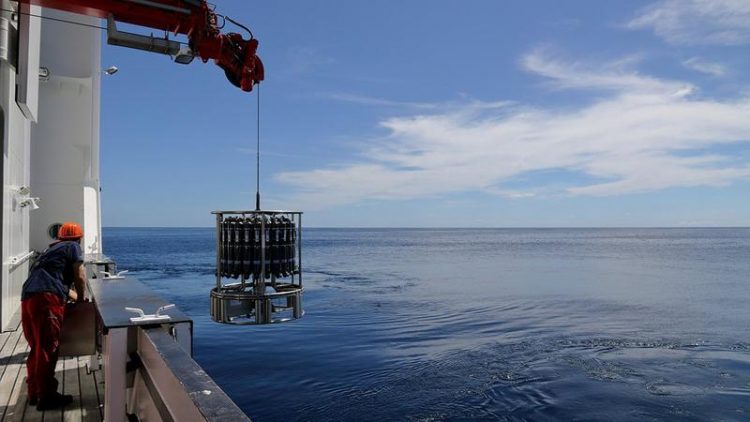Climate change weakens Walker circulation

With the help of a device called a CTD rosette, scientists can takes samples from the water column and measure water parameters such as salinity, temperature, oxygen content and particle density. Photo: MARUM – Center for Marine Environmental Sciences, University of Bremen
Strong rains that produce flooding on one extreme, and droughts on the other, influence the lives of millions of people in tropical regions.
Dr. Mahyar Mohtadi of MARUM, the Center for Marine Environmental Sciences at the University of Bremen, with a team of scientific colleagues, has studied how the atmospheric water cycle could develop in the future. Their results are published in the journal Nature Communications.
A global system of winds and ocean currents influences climate. Walker circulation, named after its discoverer, the English physicist Sir Gilbert Thomas Walker (1868-1958), plays an important role along the equator. It constitutes an atmospheric water cycle. As a result of high water temperatures, averaging 28.5 degrees Celsius, humid air masses rise above the Indonesian archipelago.
In the upper atmosphere, these split to feed two different cycles: one part flows eastward toward South America and the other westward toward Africa. The rising air masses result in the formation of a low-pressure area over Indonesia, which is responsible for the wet climate there. In contrast, off the coasts of Africa and South America, high-pressure systems develop because the air masses here descend and suppress cloud formation. These areas, therefore, usually have sparse rainfall.
How do climate changes impact climate systems?
In the present study, the researchers Mahyar Mohtadi, Matthias Prange, Enno Schefuß and Tim C. Jennerjahn, from MARUM, the Center for Marine Environmental Sciences of the University of Bremen and the Leibniz Centre for Tropical Marine Research in Bremen, have analyzed the effects of increasing temperature on the Walker circulation. In order to understand these changes it is helpful to consider a period in Earth’s history when the average temperatures were colder.
“That is why we have compared conditions during the last glacial period at about 20,000 years ago with the warmer conditions of the last 3,000 years,” says Mohtadi. Scientists use weather records applied through mathematical models to make predictions of climate in the coming decades.
It is often not sufficient to analyze only the directly measured weather data from the 20th century, because the observed changes are not comprehensive enough to provide a complete picture. For this reason, paleoclimatologists have to look further back in time. They use sea-floor deposits, which, like the rings in a tree trunk, record climate conditions in a kind of archive.
New knowledge thanks to the combination of various data and models
“Previous prognoses for the future suggest that the intensity of Walker circulation will decline as the Earth becomes warmer. The weakened circulation will result in more rain over East Africa and less rain over Southeast Asia,” explains Mohtadi. The rain would have disastrous consequences, however, because it would cause extensive flooding instead of a fertile climate for East Africa. A glimpse into the past, where cold and warm periods have alternated with increased or diminished circulation, would help to verify whether the theory of the climate researchers is correct. “As far as Walker circulation is concerned, it is correct,” concludes Mohtadi.
Mahyar Mohtadi, Matthias Prange, Enno Schefuß and Tim C. Jennerjahn combined different data sets and climate models. They included data from sediment cores off the coast of Indonesia, satellite data and measurement series, as well as a number of different climate models in which water temperatures on the sea surface are compared to those at greater depths. Further evidence was provided by plant remains in the sediments that reveal changes in precipitation through the past. Mahyar Mohtadi considers the quality of these combined data to be very high. “We have analyzed various indicators from the glacial period and compared them to those from today – it provides a robust signal.”
Contact:
Dr. Mahyar Mohtadi
Telephone: 0421-218 65660
Email: mmohtadi@marum.de
Original publication:
Mahyar Mohtadi, Matthias Prange, Enno Schefuß, Tim C. Jennerjahn: Late Holocene slowdown of the Indian Ocean Walker circulation. Nature Communications. DOI: 10.1038/s41467-017-00855-3
Partiticipating institutes:
MARUM – Center for Marine Environmental Sciences, University of Bremen
Leibniz Centre for Tropical Marine Research (ZMT), Bremen
Further information / photo material:
Ulrike Prange
MARUM public relations
Email: uprange@marum.de
MARUM, using state-of-the-art methods and through participation in international projects, investigates the role of the ocean in the Earth’s system, particularly with respect to global change. It quantifies the interactions between geological and biological processes in the ocean and contributes to the sustainable use of the oceans. MARUM comprises the DFG Research Centre and the Excellence Cluster “The Oceans in the Earth System.”
Media Contact
More Information:
http://www.marum.deAll latest news from the category: Earth Sciences
Earth Sciences (also referred to as Geosciences), which deals with basic issues surrounding our planet, plays a vital role in the area of energy and raw materials supply.
Earth Sciences comprises subjects such as geology, geography, geological informatics, paleontology, mineralogy, petrography, crystallography, geophysics, geodesy, glaciology, cartography, photogrammetry, meteorology and seismology, early-warning systems, earthquake research and polar research.
Newest articles

A ‘language’ for ML models to predict nanopore properties
A large number of 2D materials like graphene can have nanopores – small holes formed by missing atoms through which foreign substances can pass. The properties of these nanopores dictate many…

Clinically validated, wearable ultrasound patch
… for continuous blood pressure monitoring. A team of researchers at the University of California San Diego has developed a new and improved wearable ultrasound patch for continuous and noninvasive…

A new puzzle piece for string theory research
Dr. Ksenia Fedosova from the Cluster of Excellence Mathematics Münster, along with an international research team, has proven a conjecture in string theory that physicists had proposed regarding certain equations….



